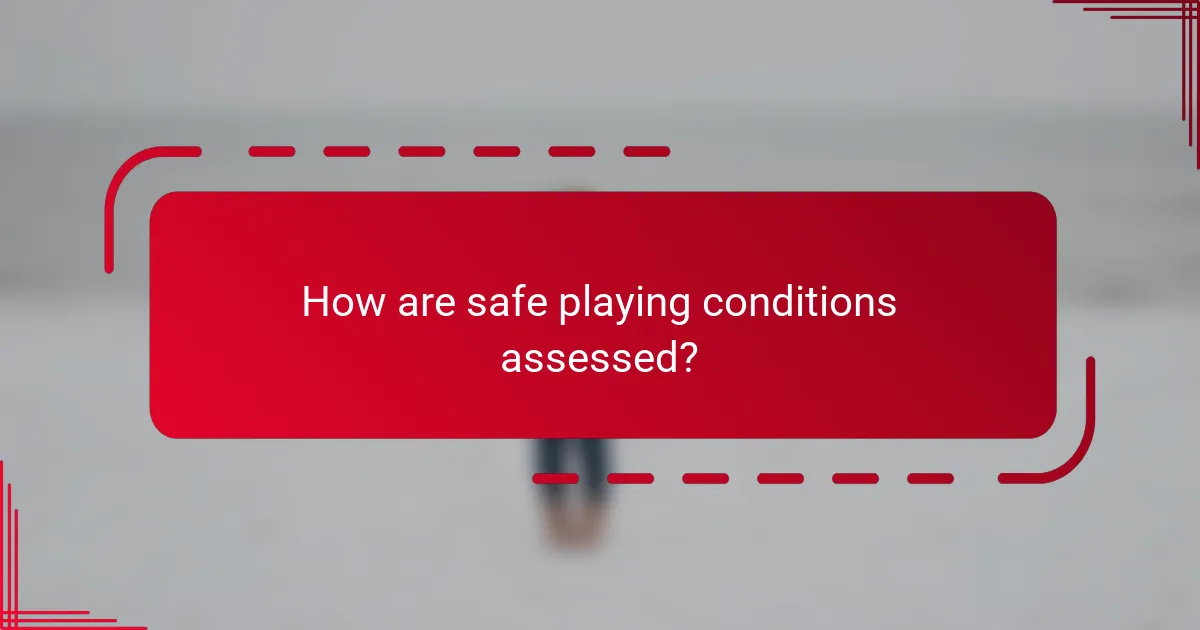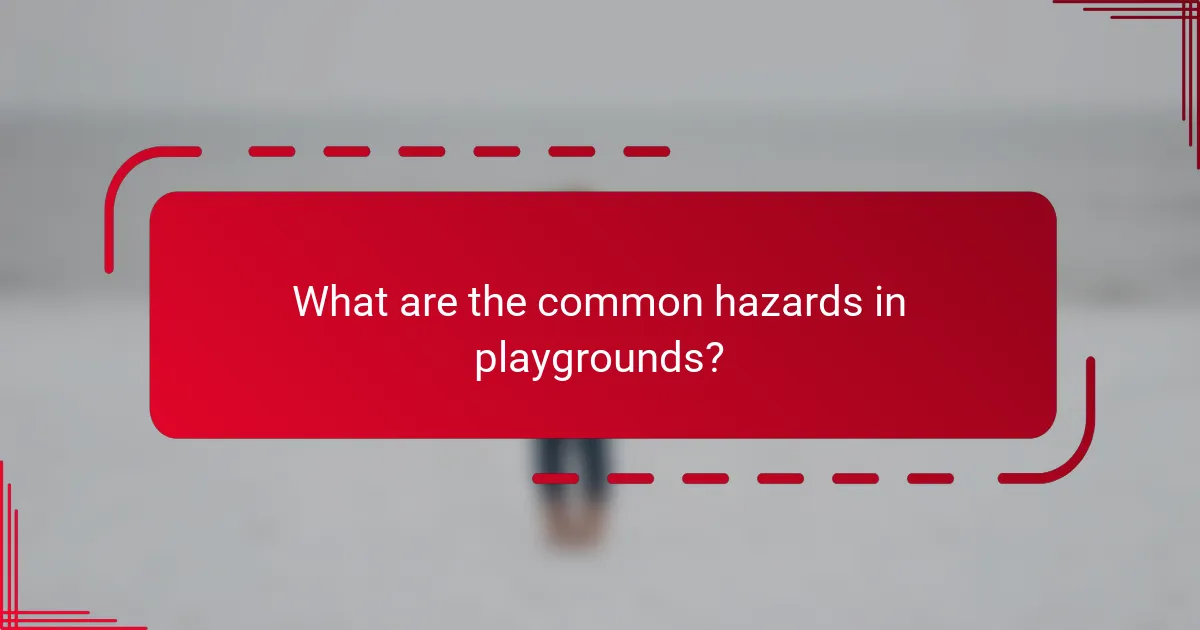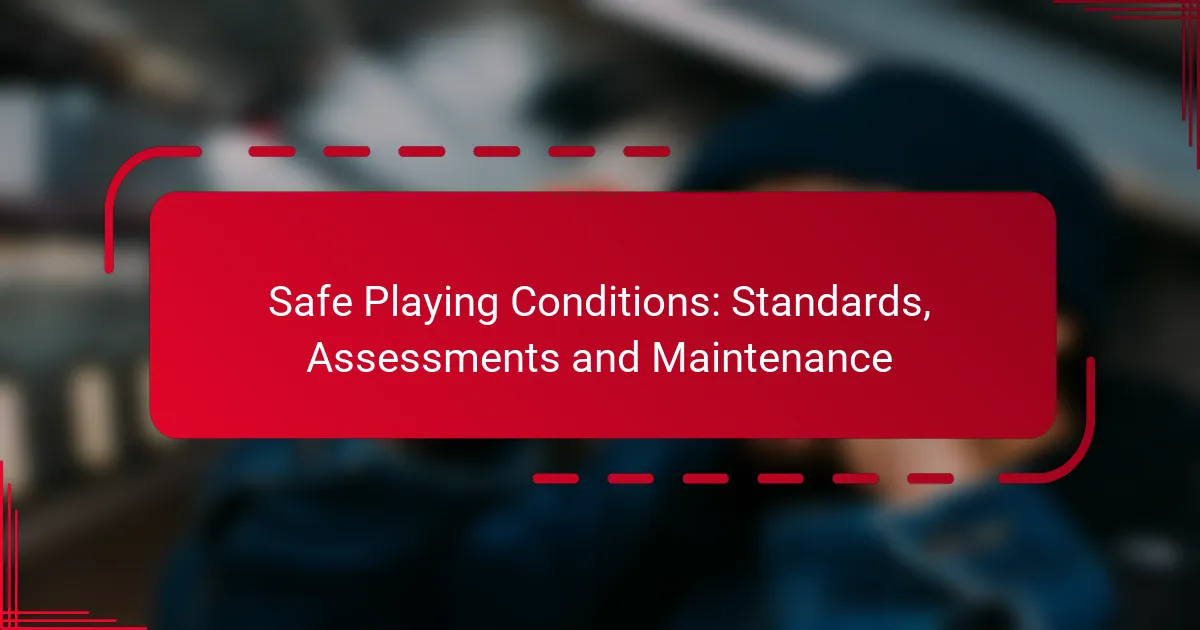Ensuring safe playing conditions is essential for promoting child safety in playgrounds, where standards dictate the design, construction, and maintenance of play areas. Regular assessments and inspections are crucial for identifying hazards and ensuring compliance with safety guidelines, while ongoing maintenance practices help uphold the integrity of equipment and surfaces. By prioritizing these measures, we can create secure environments that allow children to play freely and safely.

What are the standards for safe playing conditions?
Standards for safe playing conditions ensure that playgrounds are designed, built, and maintained to minimize hazards and promote child safety. These standards provide guidelines for equipment, surfacing, and overall site safety, helping to create environments where children can play without undue risk of injury.
ASTM F1487 standards
The ASTM F1487 standards outline safety requirements for playground equipment and surfacing. These standards focus on aspects such as equipment design, installation, and maintenance, ensuring that structures are safe for children of various ages. Compliance with these standards can significantly reduce the risk of injuries on playgrounds.
Key considerations include the height of play structures, the spacing of equipment, and the use of appropriate materials for surfacing. Regular inspections and maintenance checks are essential to uphold these standards and ensure ongoing safety.
CPSC guidelines
The Consumer Product Safety Commission (CPSC) provides guidelines that complement ASTM standards, focusing on the safety of playgrounds. These guidelines include recommendations for equipment design, installation practices, and maintenance protocols to prevent accidents. They emphasize the importance of using impact-absorbing materials for surfacing to cushion falls.
Playground operators should regularly review CPSC guidelines to stay updated on best practices. Implementing these recommendations can help reduce common hazards such as entrapment and falls, enhancing overall safety for children.
International Playground Safety Standards
International playground safety standards, such as those from ISO, provide a framework for ensuring safe play environments across different countries. These standards address various aspects of playground safety, including equipment design, maintenance, and user guidelines. They aim to create a consistent approach to safety that can be adapted to local contexts.
Adhering to international standards can help playgrounds meet safety expectations globally, making them safer for children. Playground operators should consider local regulations and how they align with international standards to ensure comprehensive safety measures are in place.

How are safe playing conditions assessed?
Safe playing conditions are assessed through systematic inspections, risk assessments, and compliance checks to ensure that play areas meet established safety standards. These evaluations help identify hazards and maintain a safe environment for children.
Playground safety inspections
Playground safety inspections involve regular evaluations of equipment and surfaces to identify potential hazards. Inspections should be conducted by trained personnel at least annually, with more frequent checks after severe weather or high usage periods.
During inspections, assess the condition of play structures, surfacing materials, and surrounding areas. Look for issues such as rust, sharp edges, or inadequate cushioning that could pose risks to children.
Risk assessment methodologies
Risk assessment methodologies involve identifying, analyzing, and evaluating risks associated with playground equipment and activities. Common approaches include qualitative assessments, where risks are categorized as low, medium, or high, and quantitative methods that estimate the likelihood and impact of incidents.
When conducting a risk assessment, consider factors such as user age, equipment design, and environmental conditions. This helps prioritize safety measures and allocate resources effectively to mitigate identified risks.
Compliance checklists
Compliance checklists are tools used to ensure that playgrounds meet safety regulations and standards. These lists typically include items related to equipment safety, surfacing materials, and maintenance practices.
Using a checklist can streamline inspections and help maintain consistent safety standards. Common items to include are checking for proper installation, ensuring adequate fall zones, and verifying that safety signage is visible and clear.

What maintenance practices ensure safety?
To ensure safe playing conditions, regular maintenance practices must be implemented, focusing on inspections, equipment upkeep, and repair protocols. These practices help identify hazards and maintain the integrity of play areas, ultimately protecting users from injuries.
Regular surface inspections
Conducting regular surface inspections is crucial for identifying wear and tear, debris, or other hazards that could compromise safety. Inspections should occur at least monthly, with more frequent checks after adverse weather conditions. Documenting findings helps track issues over time and prioritize repairs.
When inspecting surfaces, look for cracks, uneven areas, or loose materials. For playgrounds, ensure that protective surfacing, such as rubber mats or mulch, is intact and adequately thick to cushion falls. Regular inspections can prevent accidents and extend the lifespan of play areas.
Equipment maintenance schedules
Establishing equipment maintenance schedules is essential for keeping play structures safe and functional. These schedules should include routine checks for loose bolts, rust, and other signs of wear. Depending on usage, maintenance might be required weekly, monthly, or quarterly.
Incorporate a checklist for maintenance tasks, such as lubricating moving parts, tightening hardware, and checking safety features like guardrails. Keeping a log of maintenance activities helps ensure compliance with safety standards and provides a record for inspections.
Repair protocols for damaged structures
Having clear repair protocols for damaged structures is vital for maintaining safety. When damage is identified, it should be addressed immediately to prevent accidents. Establish a process for reporting damage, assessing severity, and prioritizing repairs based on risk levels.
For minor repairs, staff should be trained to handle quick fixes, such as replacing broken components or securing loose parts. More significant damage may require professional assessment and repair. Always follow manufacturer guidelines and local regulations when making repairs to ensure compliance and safety.

What are the common hazards in playgrounds?
Common hazards in playgrounds include equipment-related injuries, surface material risks, and environmental hazards. Understanding these risks helps in creating safer play areas for children.
Equipment-related injuries
Equipment-related injuries are among the most frequent hazards in playgrounds, often caused by falls from swings, slides, or climbing structures. These injuries can range from minor scrapes to serious fractures, particularly when equipment is poorly designed or improperly maintained.
To mitigate these risks, ensure that playground equipment meets safety standards such as those set by the Consumer Product Safety Commission (CPSC) in the U.S. Regular inspections and maintenance can help identify and address potential hazards before they lead to accidents.
Surface material risks
The choice of surface material significantly impacts safety in playgrounds. Hard surfaces like concrete or asphalt can increase the severity of injuries from falls, while softer materials such as rubber mulch or engineered wood fiber provide better cushioning.
It is recommended that playgrounds use impact-absorbing surfaces that comply with safety guidelines, typically requiring a minimum depth of 12 inches for loose-fill materials. Regular maintenance is essential to ensure these surfaces remain effective and free from debris.
Environmental hazards
Environmental hazards include natural elements like trees, rocks, and uneven ground that can pose risks to children playing. Additionally, weather conditions such as rain or snow can create slippery surfaces, increasing the likelihood of falls.
To enhance safety, regularly inspect the playground for potential environmental hazards and remove any obstacles. Implementing proper drainage systems can also help reduce water accumulation and maintain safe play conditions year-round.

How can communities promote safe play environments?
Communities can promote safe play environments by actively engaging residents, securing funding for safety improvements, and forming partnerships with local organizations. These strategies help ensure that play areas meet safety standards and are well-maintained, providing children with secure spaces to play.
Community engagement initiatives
Community engagement initiatives involve involving local residents in discussions about play area safety. This can include surveys, town hall meetings, or workshops where parents and children can voice their concerns and suggestions. Engaging the community fosters a sense of ownership and responsibility towards maintaining safe play environments.
Additionally, organizing volunteer days for maintenance and improvement projects can strengthen community ties and enhance the physical condition of play areas. These initiatives can lead to increased awareness of safety standards and encourage proactive measures to address potential hazards.
Funding for safety upgrades
Securing funding for safety upgrades is crucial for improving play environments. Communities can explore various funding sources, including local government grants, fundraising events, and partnerships with businesses. Allocating budget for regular inspections and necessary repairs can prevent safety issues from escalating.
Communities should prioritize projects based on need and potential impact. For example, replacing outdated equipment or resurfacing playgrounds can significantly enhance safety. Establishing a clear plan for funding allocation can streamline the process and ensure that resources are effectively utilized.
Partnerships with local organizations
Forming partnerships with local organizations can amplify efforts to create safe play environments. Schools, non-profits, and health organizations can collaborate on safety assessments and community programs. These partnerships can also provide access to additional resources and expertise in safety standards and maintenance practices.
Moreover, local businesses can contribute through sponsorships or donations, helping to fund safety upgrades or community events. By working together, communities can leverage shared goals to enhance the safety and quality of play areas for children.

What role do local regulations play in playground safety?
Local regulations are crucial for ensuring playground safety as they establish standards and guidelines that must be followed. These regulations help minimize risks and provide a framework for assessing and maintaining safe play environments for children.
State-specific safety regulations
Each state in the U.S. has its own set of safety regulations that govern playground design, installation, and maintenance. These regulations often align with national standards, such as those from the Consumer Product Safety Commission (CPSC) and the American Society for Testing and Materials (ASTM), but may include additional requirements specific to the state. For example, some states may mandate specific surfacing materials to reduce injury risks.
Local ordinances for playgrounds
Local ordinances can further refine safety standards by addressing community-specific needs and conditions. These ordinances may dictate the types of equipment allowed, maintenance schedules, and safety inspections. For instance, a city might require annual safety audits for all public playgrounds to ensure compliance with both state and local regulations.
Enforcement of safety standards
Enforcement of safety standards is typically the responsibility of local authorities, who may conduct inspections and issue fines for non-compliance. Regular inspections help identify hazards and ensure that playgrounds are maintained according to established safety protocols. Communities should encourage reporting of unsafe conditions and ensure that there are clear procedures for addressing safety concerns promptly.
